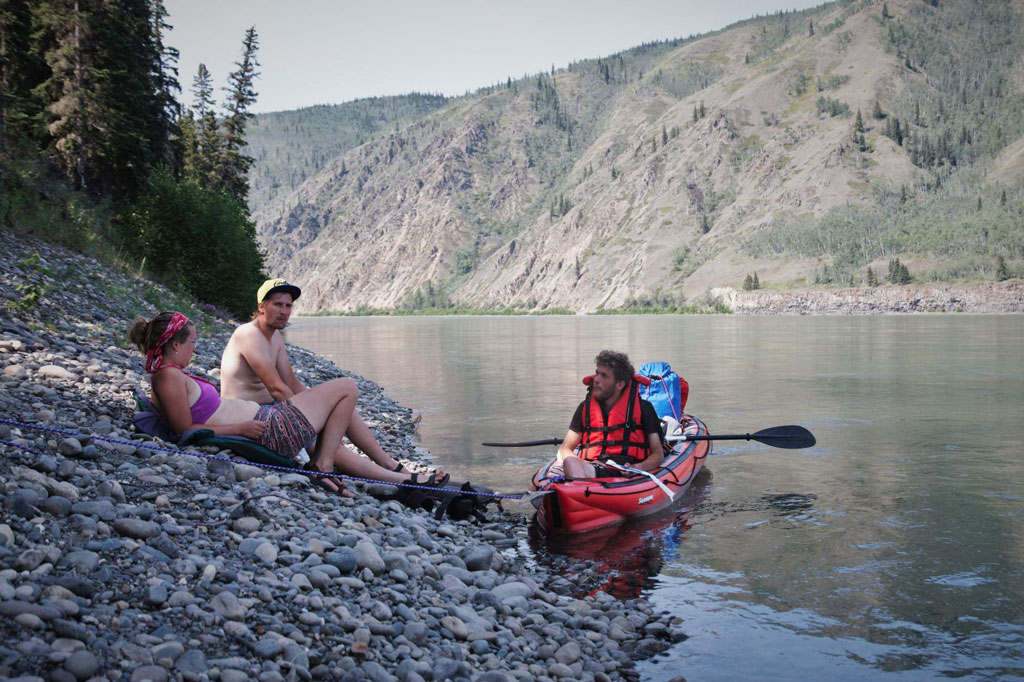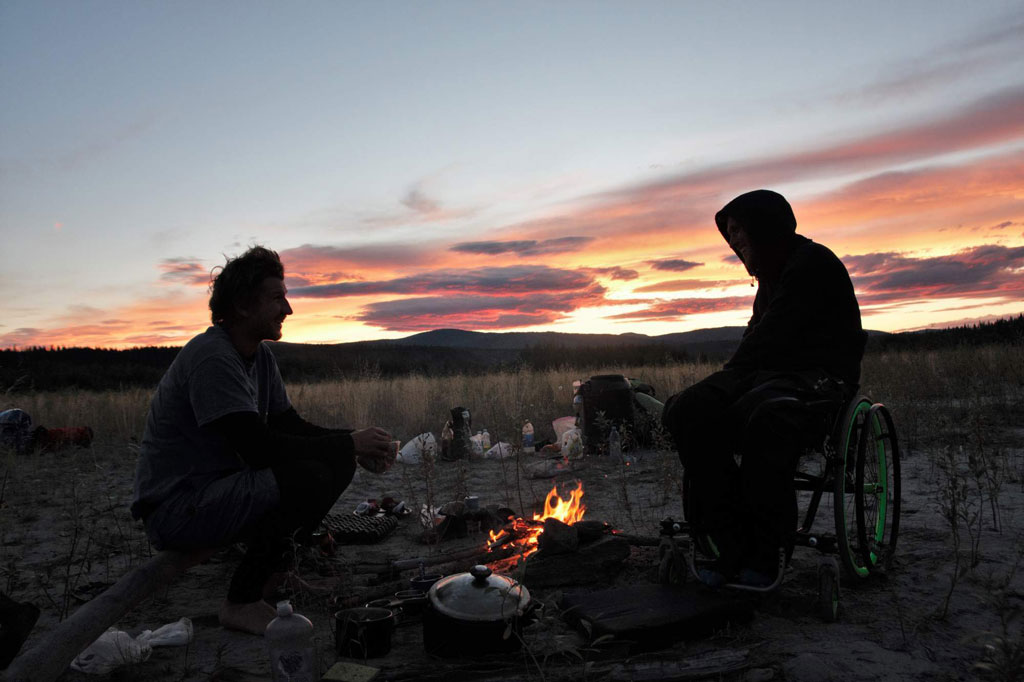blog
HONEYMOON ON THE YUKON RIVER
TEXT: Jiří Čeloud, instructor of self-sufficiency training at the Paraple Centre
PHOTO: Archive of Jiří Čeloud
The article was created for PARAPLE MAGAZINE
I met Katerina for the first time at the Paraple Centre cycling course five years ago. Now, with the rings on our hands, we are packing all the gear we will need to survive a month-long honeymoon into huge boat bags.
Most of the space was taken up by the river equipment we had hastily bought in Hiku. From neoprene socks to life jackets. We had nothing at all, which is not a big surprise since I’ve been on the river three times in my life. As a kid on the Dyje and twice on the Vltava.
The idea that in a week I would be floating down the Yukon and swimming like gold miners all the way to Dawson City was exciting. Especially since I can’t swim.
We arrived in Whitehorse, the capital of the Yukon Territory, in mid-July. We were scared of mosquitoes, bears and a little bit of ourselves. At the airport we were greeted by Jenda and Bětka with a banner Jirka+Kačka=(A)Láska (means love or Alaska).
They had been in Canada for a year, tried a few jobs, made some money, and now had a quarter of a year to travel, a month of which they were going to spend with us.
After we packed our stuff into the old Chevy Venture, we drove to a campsite overlooking the river a short distance from the airport. We built a small fire, cracked open a bottle of Kraken, and chatted into the morning. It was Betsy’s birthday. Good thing we bought her some candy, because she loves presents. It seemed like a carefree evening, but in reality we were carrying „bear spray“ and kind of waiting for a bear to come out of the bushes.
He didn’t come out, so we headed to Johnson’s Crossing on the Teslin River, where we boarded our inflatable boats. Jenda and Betka had a canoe from the Kutlik’s, we had an inflatable seakayak. I was able to fully paddle in it and it was relatively safe. We somehow put all the equipment, including the cart, together, loaded it up and off we went.
What I didn’t know about myself, however, was that I am quite extremely allergic to neoprene. So the very next day a helicopter flew for me, swollen and festering, thanks to the satellite phone of the guide of another paddling group. „No drama,“ as Jenda said, but there was no other way to handle it. We wouldn’t meet more people, or be able to call for help, for another week at the earliest.
At the hospital, I got an IV, slept, took a shower in the morning, said thank you and left. It was a lot more complicated than that, of course, but that would be a long story.
I met the others two days later at the „McDonalds“ in Whitehorse. All that time they were paddling upstream and under the influence of slivovitz (great slavic spirit), while I stayed in a hotel for one hundred and sixty dollars a night. A honeymoon as fuck!
From the „McDonalds“ we drove to Carmacks, where we found a great campsite just below the Five Finger rapids, which were the last mortal danger for gold miners during the gold rush. We were there for three days before my body recovered a little more. And then, with a vision of a better tomorrow, we got back in the boats.
The Yukon was flowing quite fast and there were a lot of eddies in the water that took some getting used to. On the other hand, we didn’t encounter dangerous rapids until Dawson.
The river is over three thousand miles long, and we paddled about a tenth of that – it came out of Carmacks at about three hundred and eighty. We reckoned we could do it in eight or nine days, and our wives adjusted our food supplies accordingly. We filtered the water along the way.
There were lots of small islands in the river tens, sometimes hundreds of yards from shore, which was great for overnight camping. I guess if a bear wanted to swim in, it probably would have anyway, but we weren’t too worried. That is, until the third day when one stared at us from the shore. We fired a „bear banger“ at him, which is a firecracker inserted into a plastic tube with a spring to scare him away. It didn’t do much good, he came from the other side. Although it was getting close to midnight and we were very tired, we packed up camp and floated down the river for another hour before we found a safer spot.
I must admit that it was only here that I understood the power of nature. There were countless animals watching us from the shore. A huge grizzly bear with her cub, smaller black bears, sunning lynx, moose, reindeer, beavers, eagles flying above us…
Therefore…you don’t meet many people here. Now and then a waterman, sometimes an first nation guy with a boat full of fish. When we weren’t paddling, we were reading aloud a book about Šumava loners. No one had any idea what time it was, or where we were, or how far we had paddled.
We reached the finish line on the eighth day. Dawson is a special place. At its height in the late 19th century, it was home to about 30,000 people. There were theatres, an opera house, many restaurants, but also brothels and dance halls.
Now some might call it a backwater, but for me it was a peaceful town with some quite extraordinary or even disgusting traditions. For example, with a whiskey glass and a real human finger that, if you touch your lips while drinking, you get a diploma. Mine’s serial number 81,686.
Jenda and Bětka hitchhiked to get the car and we enjoyed a few hours alone with Kačenka. The next day we crossed the border between Canada and the USA. In Tok we connected to the Alaska highway and drove to Fairbanks, where we figured out what to do next.
At the Denali Park information desk, the guy behind the computer told us: „Wow, you guys are lucky, someone just checked out and you can drive to the park and stay for three days at the Teklanika campsite.
Normally you need to book a place several months in advance.“
Great! It was a few dozen kilometres to the campsite on a gravel road and it was an absolutely fascinating journey. From the campsite it was another eighty kilometres to Wonder Lake, which was reached by bus every half hour. Buses have the advantage that you can get on and off them anywhere. But the best part of it all was that every other such camper bus here had a wheelchair platform installed.
The next day we boarded it, and although none of us are fans of this commercial kind of travel, we had to admit that the „Americans“ have done it really well. The driver was talking into a microphone the whole way. If she saw a bear, a moose, or we were in a place where a pack of wolves sometimes appears, she would stop and let people look and snap a picture. The next day, Jenda and I went on a handbike trip along the same road and the girls went hiking in the mountains.
We were down to our last few days. We drove to Anchorage, where we rented part of a house for one night through AIRBNB. We washed our dirty clothes and ourselves, cooked a great dinner and relaxed.
Before our departure, we managed to drive up to the mountains to the lake, where we took out our paddling gear for the last time and paddled to the glacial run. Beautiful! I almost fell out of the boat every now and then as the wind and waves battered it, but it was a powerful experience.
We said goodbye to Jenda and Bětka at the airport in Anchorage. There was more traveling and duties ahead of us, three transfers and fifty-four hours on the way to Prague. The marriage survived!












